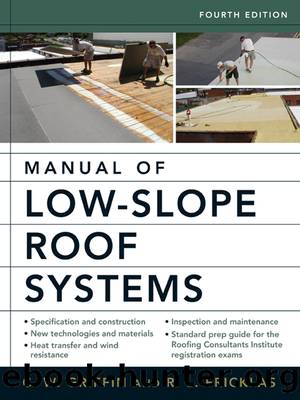Manual of Low-Slope Roof Systems : Fourth Edition by Griffin C.W.; Fricklas Richard

Author:Griffin, C.W.; Fricklas, Richard
Language: eng
Format: epub
Tags: Architecture/Methods&Materials
Publisher: McGraw-Hill Companies, Inc.
Published: 2012-03-18T16:00:00+00:00
TABLE 11.2 ASTM Standards for APP Modified Bitumen
TABLE 11.3 ASTM Standards for SBS Modified Bitumen
Figure 11.3 Propane torching of APP-modified-bitumen sheets is mandatory because APP-modified asphalt cannot be melted with hot-mopped asphalt. (Tamko.)
Reinforcement
Located within the modified-bitumen sheet cross section, reinforcement serves several purposes:
As a carrier during factory production
As a means of increasing tensile strength and puncture resistance
As a fire-protection enhancement
As a structural element bridging substrate gaps
The particular properties imparted by reinforcement depend upon two factors: the type of fabric and its material. Reinforcing fabrics come in three types:
Scrims
Nonwoven (i.e., mats)
Composites (i.e., scrim and nonwoven)
Scrims are open fabrics comprising two sets of yarns perpendicular to each other and held together by weaving or adhesive bonding. Scrims offer high tensile and tear strength in both machine (longitudinal) and cross-machine (transverse) directions.
Nonwoven fabrics comprise randomly distributed fibers bonded thermally, chemically, or mechanically (or some combination of these three techniques). Their dense overlapping arrangement of fibers provides good puncture resistance. Breaking strain depends on the fiber material, its orientation, and its bonding strength.
Composites combine scrim and nonwoven fabrics, chemically or mechanically bonded. Materials are chosen for special properties. Composites and nonwovens are common as modified-bitumen reinforcement. Because they must function as carriers during the manufacturing process, when they must retain the polymer-bitumen mix, scrims generally are unsuitable for modified-bitumen reinforcement, except in combination with nonwovens.
The predominant materials used as modified-bitumen reinforcement are glass fibers and polyester. Glass fibers provide better dimensional stability, fire resistance, and ultraviolet resistance. Polyester provides greater strain energy. (At low temperature, it has nearly 50 percent breaking strain versus 10 percent for glass-fiber mats.) Polyester also has greater flexibility and fatigue and puncture resistance.
A composite reinforcement might be designed as a polyester nonwoven, chosen for superior puncture resistance and strain energy, adhered to a glass-fiber scrim, chosen for dimensional stability.
The no-free-lunch rule asserts itself in these material and fabric selections. Polyester’s relatively low ultraviolet and fire resistance detracts from its puncture resistance. Glass fiber’s greater dimensional stability comes with a countervailing liability: the notorious glass-fiber “memory” (i.e., its tendency to retain kinks and other irregularities instead of relaxing like more flexible materials). Woven glass cloth reinforcement exhibits less memory than nonwoven glass-fiber mats. It makes a good reinforcement for modified flashing sheets, where memory poses a special hazard. (Flashing material must be moldable, to conform with its backing surfaces.) But even in membrane sheets, memory poses a problem, causing sheets to bridge over irregularities in a substrate or to leave end lap voids that can grow into blisters.
In an effort to exploit the complementary properties of polyester and glass fiber, manufacturers sometimes use two layers of reinforcement instead of a single composite layer. This increases the risk of delamination, especially if the sheet is heated excessively on the top side, where the reinforcement is close to the surface. Another approach features use of a glass-reinforced base sheet combined with a polyester-reinforced cap sheet.
Download
This site does not store any files on its server. We only index and link to content provided by other sites. Please contact the content providers to delete copyright contents if any and email us, we'll remove relevant links or contents immediately.
Audition by Ryu Murakami(4099)
The Body: A Guide for Occupants by Bill Bryson(3801)
Adulting by Kelly Williams Brown(3670)
Housekeeping by Marilynne Robinson(3401)
Zero Waste Home by Bea Johnson(3291)
Be in a Treehouse by Pete Nelson(3212)
Seriously... I'm Kidding by Ellen DeGeneres(3100)
Better Homes and Gardens New Cookbook by Better Homes & Gardens(2954)
Barkskins by Annie Proulx(2880)
The Healing Self by Deepak Chopra(2796)
Hedgerow by John Wright(2776)
The Life-Changing Magic Of Tidying Up- The Japanese Art Of Decluttering And Organizing (v5.0) by Marie Kondo(2745)
Spark Joy by Marie Kondo(2677)
The Genius of Japanese Carpentry by Azby Brown(2609)
The Cellar by Natasha Preston(2595)
Work Clean by Dan Charnas(2562)
120 Days of Sodom by Marquis de Sade(2438)
The Book of Numbers by Peter Bentley(2404)
A Monk's Guide to a Clean House and Mind by Shoukei Matsumoto(2404)
